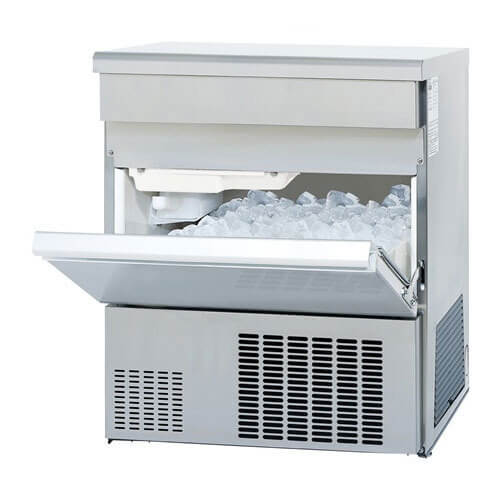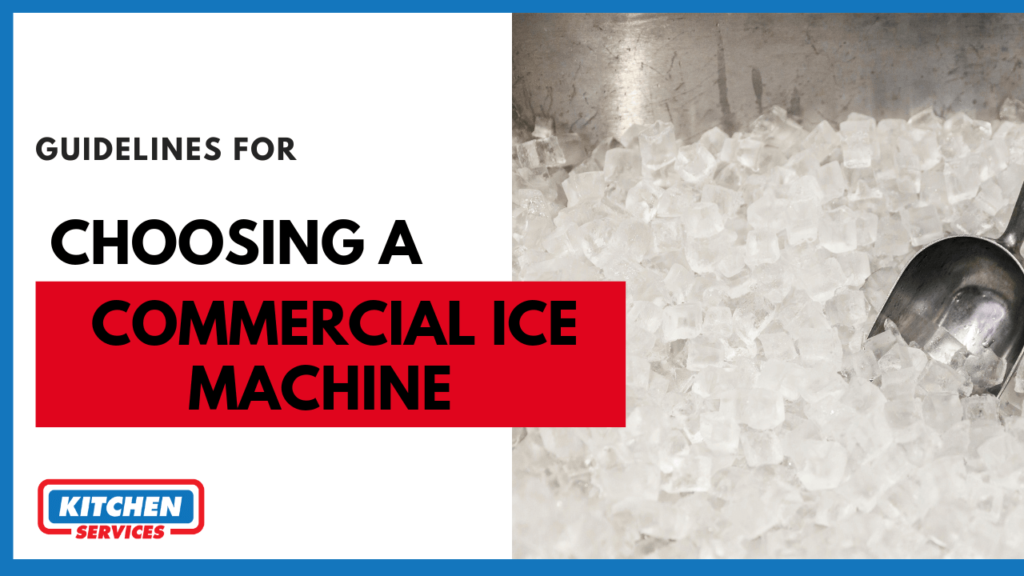Ice-making machines work to produce a lot of ice through a simple process which is known as adiabatic cooling. In this process a highly pressured substance tends to expand, this unusual change in pressure then causes the substance to cool very quickly. Refrigerant is very important in the function of a commercial ice machine.
Nowadays refrigeration systems work in such a way that they use some form of refrigerant to get water cold in such a way that the water freezes and creates ice. All the way through the refrigerant’s journey, it continues to heat and cool. During all these heating and cooling phases, the refrigerant tends to change its physical state, from liquid to vapor and back to liquid again. At the time when the refrigerant reaches the evaporator, it should be in the form of a low-pressure and low-temperature liquid. At this stage, the heat in the water travels towards the cold refrigerant which then lowers the temperature of the water to the extent that it becomes ice.
How Does a Commercial Ice Maker Work?
A commercial ice maker works by using a refrigeration system to freeze water into ice cubes. Water is pumped into molds, usually made of metal, and cooled by a refrigerant. The cooling process extracts heat from the water, causing it to freeze into the desired shape. Once the ice forms, a heating element or reverse refrigeration cycle warms the molds slightly to release the cubes. The ice is then harvested and stored in a bin. Some commercial ice makers have filters to ensure clean water, and they can produce ice continuously, ideal for high-demand environments like restaurants or hotels.
How to buy a Commercial Ice Machine?

No matter what you are going to buy for your convenience whether it is a dishwasher or an ice-making machine you always have to spend your money wisely. Spending your hard-earned money wisely also means buying your required equipment from a well-reputed and proper retailer. Along with that, you would never want to spend your money on such a thing that does not offer any sort of ease or resilience. Usually, those people who run commercial kitchens have a proper idea about what kind of dishes they want to offer and their focus audience. But at the same time, they might not have proper information about the equipment they need to use such as cooking ranges, refrigerators, commercial ice machines, etc. so all the power goes to the retailers and all they can do is ask the retailer which machine or equipment is best for their use. This is why it is very crucial to purchase all the appliances you need from an experienced retailer.
Each piece of equipment in a commercial kitchen has its own features and advantages. Therefore, when you shop for any of these appliances, you will need to consider particular specific characteristics of the product.
Here is an overview of the things that you might consider before buying a commercial ice machine for your commercial kitchens.
Types of Ice You Require
Every different kind of commercial ice machine makes different kinds and shapes of ice. It totally depends on your preference that which kind of ice you require. The different kinds of ice include
- Flake ice
- Gourmet ice
- Nugget ice
- Cubes ice
- Top hat ice
you may see what kind of these you require in your commercial kitchen and then decide which kind of ice-making machine is suitable for you.
Types of Ice Makers
1. Modular Ice Machine (IMH)
- Features: Stackable units that produce high quantities of ice.
- Sizes: Common widths are 22″, 30″, and 48″.
- Ice Output: Ranges from 200 to 1,900 lbs. per day.
- Storage: Typically paired with a storage bin that holds about 12 hours’ worth of ice.
- Uses: Suitable for large businesses needing a high volume of ice, often paired with dispensers or soda machines.
2. Undercounter Ice Machines
- Features: Self-contained units combining the ice maker and storage bin.
- Size: Compact, fitting under 40″ high countertops.
- Ice Output: Average production is about 350 lbs. per day.
- Uses: Ideal for smaller businesses with moderate ice demands and limited space.
3. Countertop Ice Dispenser
- Features: Small units often with both ice and water dispensing capabilities.
- Ice Output: Can produce up to 400 lbs. of ice per day.
- Ice Type: Commonly dispenses nugget ice, which is easy to chew.
- Uses: Popular in healthcare settings where space is limited, and nugget ice is preferred for patient use.
Types of Condensers
1. Air-Cooled Condensers
- Function: Air is blown over the refrigeration lines to dissipate heat from high-pressure areas.
- Components: Utilizes fans and air vents to maintain airflow and cooling.
- Advantages: Common, cost-effective, and relatively simple to install and maintain.
- Considerations: Works best in well-ventilated areas with room for airflow. Performance may decline in hot, enclosed spaces.
2. Water-Cooled Condensers
- Function: Uses water to cool refrigerant vapor, condensing it into a liquid.
- Components: Requires two water lines—one for making ice and the other for cooling the condenser.
- Advantages: Quieter and more efficient than air-cooled systems, particularly in hot or contaminated environments.
- Considerations: Higher water usage can lead to increased utility costs. Some areas may restrict or ban water-cooled units due to their water consumption.
3. Remote-Cooled Condensers
- Function: Similar to air-cooled systems, but the condenser is installed outdoors, usually on a roof.
- Components: Connected to the ice machine via refrigeration lines, with cooling taking place outside the building.
- Advantages: Quieter operation indoors, as the condenser is located remotely. Ideal for large operations like grocery stores.
- Considerations: More expensive to install and maintain due to the complexity of outdoor placement and refrigeration line installation.
Size and Storage
1. Size and Capacity
- Range: Ice storage bins typically hold between 40 lbs. and 100 lbs. of ice.
- Key Consideration: Bigger isn’t always better. If the bin is too large, unused ice will melt and refreeze, leading to waste and potential contamination.
2. Contamination Risk
- Melted Ice: Ice left for long periods can melt, creating pools of water that become breeding grounds for bacteria and mold.
- Solution: Regular cleaning and maintenance are essential to prevent contamination. Some suppliers offer cleaning services as part of a package.
3. Replacement or Upgrade
- Evaluate Needs: If you are upgrading or replacing your ice machine, assess the previous machine’s performance. Did it meet your needs, or did you need more capacity?
- Forecast Growth: Plan for future business growth, but don’t overestimate, as it can lead to unnecessary waste.
4. Peak Time Usage
- Ice Consumption: Consider how much ice your business needs during peak hours. This will give a clearer picture of the bin size required.
- Example: A restaurant might need 900 lbs. of ice on weekends but only half that amount during the week.
5. Machine and Bin Capacity
- Mismatched Capacities: Your bin size doesn’t need to match the machine’s full capacity. You can pair a smaller ice machine with a larger bin to ensure ample storage during peak periods without overproducing during slow times.
Also Read: How to clean ice machine
Ice Usage Guidelines for Different Business Types
| Industry Type | Number of Customers | Daily Ice Usage (lbs) |
|---|---|---|
| Full-Service Restaurant | 100 customers | 150 – 200 lbs |
| Fast Food/Quick Service | 100 customers | 40 – 60 lbs |
| Hotel/Motel (Guest Ice) | 100 rooms | 500 lbs |
| Coffee Shop/Café | 100 customers | 50 – 100 lbs |
| Convenience Store (Soda) | 100 customers | 35 – 50 lbs |
| Healthcare Facility | 100 patients | 1,000 lbs |
| Catering/Event Venue | 100 guests | 100 – 400 lbs |
| Seafood Market (Display) | 100 cubic feet | 3,000 – 3,500 lbs |
| Supermarket (Drink Station) | 100 customers | 35 – 50 lbs |
| Sports Facility/Gym | 100 customers | 100 lbs |
| School/University Cafeteria | 100 students | 100 lbs |
How To Buy A Commercial Ice Machine FAQs
How do I choose a commercial ice maker?
When choosing a commercial ice maker, consider daily ice needs and select the appropriate capacity and ice type. Measure your kitchen space, ensure accessible water and drainage, and prioritize energy efficiency for cost-effective operation and minimal maintenance.
What size commercial ice maker do I need?
A good rule of thumb is to select an ice maker that produces about 20% more ice than your daily needs. So if your operation needs 500 pounds of ice per day, purchase a 600 lb ice maker. Once your needs exceed 1000 lbs per day, then 10% additional output should suffice.
Do ice machines use a lot of electricity?
Ice machines can use a significant amount of electricity, but the exact consumption depends on the machine’s size, type, and efficiency. Larger commercial ice machines, especially those used in restaurants and hotels, require more power due to their continuous production and refrigeration processes. Factors like the ambient temperature, water quality, and machine maintenance also affect energy usage.

